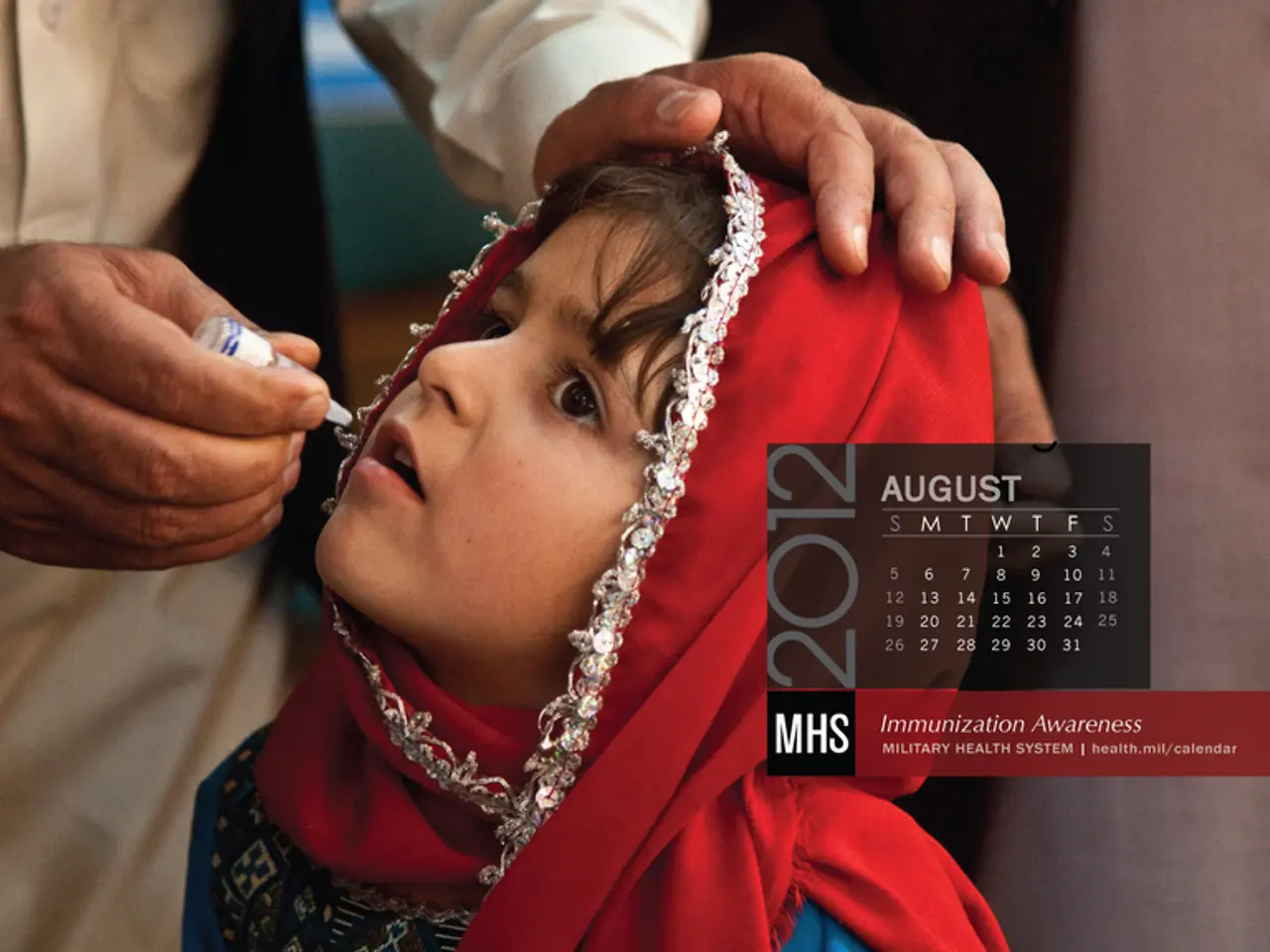Rise in Measles Cases Across European Region, stating that Romania experiences the highest number of cases in 2024
Headline: Europe Experiences Dramatic Increase in Measles Cases, with Romania Being Heavily Affected
Europe has witnessed a significant surge in measles cases in 2024, with 127,350 cases reported—double the number from 2023 and the highest since 1997[1][2][5]. Romania was one of the countries heavily affected, with a major outbreak starting in 2023 and gradually subsiding in 2024[3].
Causes of the Increase in Measles Cases in Europe 2024
The resurgence of measles cases in Europe can be attributed to several factors. A decline in vaccination coverage or delays in measles-containing vaccine administration have contributed to reduced herd immunity[1]. International travel and migration have facilitated the spread, as clusters have been linked to outbreaks in countries like Romania and Morocco[3]. Vaccine hesitancy and misinformation remain obstacles in some populations[1]. Some countries experienced lapses in surveillance and public health response, enabling easier transmission[1].
Impact of Increased Measles Cases
Measles is especially dangerous for young children and unvaccinated individuals, leading to serious complications such as pneumonia, brain inflammation, deafness, blindness, and even death[5]. In 2023, over half of children infected with measles in Europe required hospitalization[5]. The resurgence threatens public health progress, especially the goal of measles elimination in the WHO European Region[1]. Beyond individual cases, outbreaks strain healthcare systems and require extensive contact tracing and vaccination campaigns[3].
Efforts to Combat Measles Outbreaks in Romania
In response to the outbreak, Romania has implemented intensified outbreak control measures, including mass vaccination campaigns targeting unvaccinated children and adults. Public health authorities have increased awareness and communication efforts to counter vaccine hesitancy. Enhanced surveillance and case reporting continue to monitor and contain the outbreak[3]. Neighboring countries like the Netherlands and UK are monitoring travelers from Romania closely to prevent spread[3]. Health agencies advocate for timely administration of two doses of the MMR (measles, mumps, rubella) vaccine to restore immunity at the population level.
Despite ongoing efforts, measles remains a critical challenge in Europe for 2024, especially in affected countries like Romania, requiring continued coordinated vaccination and outbreak response strategies[1][2][3][5]. Vaccination rates have remained critically low in some countries, fueling the current measles outbreaks. WHO and UNICEF are urging governments, especially in countries like Romania, to increase vaccination efforts and close coverage gaps[1]. In 2023, vaccination coverage with the first dose of the measles vaccine (MCV1) was below 80% in countries such as Romania, Bosnia and Herzegovina, Montenegro, and North Macedonia[1]. Preliminary data indicates that 38 deaths have occurred due to complications from measles in the Region. A rise in cases occurred in 2018 and 2019, with 89,000 and 106,000 cases, respectively[1]. In 2024, the European Region has seen a significant increase in measles cases, with a total of 127,350 cases reported across 53 countries[1]. Romania reported the highest number of cases in the Region for 2024, with 30,692 cases[1]. More than half of the infected children require hospitalization[1]. WHO and UNICEF are working to strengthen immunization programs, train healthcare workers, and launch catch-up vaccination campaigns to stem the tide of infections[1]. The COVID-19 pandemic has led to a decline in vaccination rates, contributing to the surge in measles cases in 2023 and 2024[1].
[1] World Health Organization (WHO) and UNICEF, Measles Situation Report, Week 14, 2024. [2] European Centre for Disease Prevention and Control (ECDC), Measles Outbreaks in the European Union/European Economic Area, 2024. [3] Romanian Ministry of Health, Measles Outbreak Response in Romania, 2024. [5] Centers for Disease Control and Prevention (CDC), Measles: Symptoms, Complications, and Prevention.
- The resurgence of measles cases in Europe is a significant challenge in the field of health-and-wellness, particularly in 2024.
- Low vaccination coverage or delays in measles-containing vaccine administration have weakened herd immunity, contributing to the rise in measles cases.
- International travel and migration have facilitated the spread of measles, with clusters linked to outbreaks in countries like Romania and Morocco.
- Vaccine hesitancy and the spread of misinformation continue to pose obstacles in some populations.
- Some countries experienced lapses in surveillance and public health response, enabling measles to spread more easily.
- Measles is particularly dangerous for young children, leading to serious complications such as pneumonia, brain inflammation, deafness, blindness, and even death.
- In 2023, over half of children infected with measles in Europe required hospitalization.
- The resurgence of measles threatens the progress towards measles elimination in the WHO European Region.
- Outbreaks strain healthcare systems and require extensive contact tracing and vaccination campaigns.
- In response to the outbreak, Romania has implemented mass vaccination campaigns targeting unvaccinated children and adults.
- Public health authorities in Romania have increased awareness and communication efforts to counter vaccine hesitancy.
- Enhanced surveillance and case reporting are used to monitor and contain the outbreak in Romania.
- Neighboring countries like the Netherlands and UK are monitoring travelers from Romania closely to prevent spread.
- Health agencies advocate for timely administration of two doses of the MMR (measles, mumps, rubella) vaccine to restore immunity at the population level.
- Measles remains a critical challenge in Europe, requiring continued coordinated vaccination and outbreak response strategies.
- Vaccination rates have remained critically low in some countries, fueling the current measles outbreaks.
- WHO and UNICEF are urging governments, especially in countries like Romania, to increase vaccination efforts and close coverage gaps.
- In 2023, vaccination coverage with the first dose of the measles vaccine (MCV1) was below 80% in countries such as Romania, Bosnia and Herzegovina, Montenegro, and North Macedonia.
- Preliminary data indicates that 38 deaths have occurred due to complications from measles in the Region.
- A rise in cases occurred in 2018 and 2019, with 89,000 and 106,000 cases, respectively.
- In 2024, the European Region has seen a significant increase in measles cases, with a total of 127,350 cases reported across 53 countries.
- Romania reported the highest number of cases in the Region for 2024, with 30,692 cases.
- More than half of the infected children require hospitalization.
- WHO and UNICEF are working to strengthen immunization programs, train healthcare workers, and launch catch-up vaccination campaigns to stem the tide of infections.
- The COVID-19 pandemic has contributed to the decline in vaccination rates, leading to the surge in measles cases in 2023 and 2024.
- The science of environmental-science plays a crucial role in understanding and mitigating the impact of climate change on vaccine storage and distribution infrastructure.
- Investments in workplace-wellness, including mental-health, fitness-and-exercise, and nutrition, are essential components of business strategies, leading to higher productivity and improved quality of life in the automotive, manufacturing, retail, and entrepreneurship industries.








